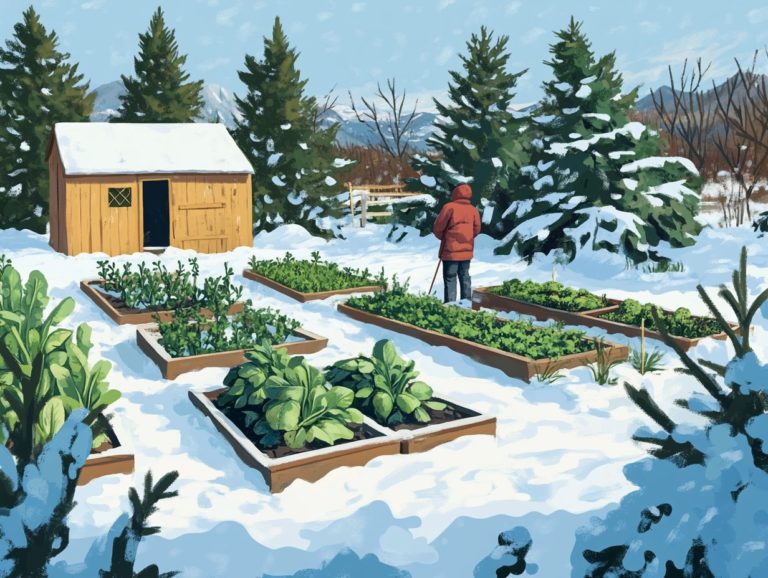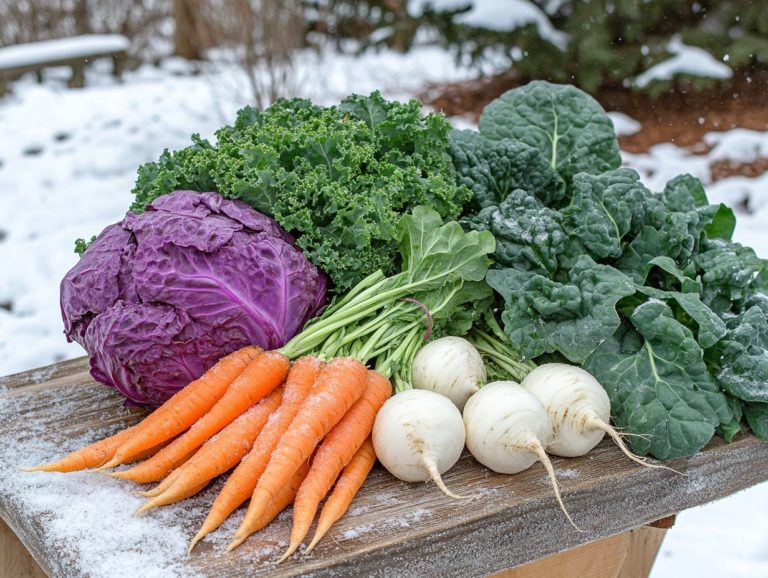Best Plants for Attracting Birds in Cold Climates
Attracting birds to your garden can turn it into a lively, vibrant sanctuary! This not only benefits local ecosystems but also enhances your outdoor experience, especially during harsh winter months.
This article delves into the essential role of welcoming our feathered friends, particularly in colder climates where their survival can be quite challenging.
You ll explore key factors to consider, discover top plants that offer food and shelter, and gather practical tips for creating an inviting bird-friendly environment.
Whether you’re a seasoned gardener or just dipping your toes into the gardening world, you’ll find ample inspiration to enhance your outdoor space for our avian neighbors!
Contents
- Key Takeaways:
- Benefits of Attracting Birds to Your Garden
- How to Help Birds in Cold Weather
- Top Plants for Attracting Birds in Cold Climates
- Tips for Creating a Bird-Friendly Garden
- Frequently Asked Questions
- What are the best plants for attracting birds in cold climates?
- Why are these plants good for attracting birds in cold climates?
- Do these plants need any special care in cold climates?
- Can these plants also attract other types of wildlife?
- How can I incorporate these plants into my landscape design?
- Are there any other benefits to having these plants in a cold climate?
Key Takeaways:

- Attracting birds to your garden is vital for both its health and the ecosystem.
- In cold climates, use native plants that provide shelter, food, and nectar for birds.
- Create a bird-friendly garden with a variety of plants, a water source, and minimal pesticide use.
Benefits of Attracting Birds to Your Garden
Attracting birds to your garden brings an array of benefits! Birds play a crucial role in pest control by feasting on insects, while also pollinating flowering plants, creating a thriving garden environment.
Their presence enhances the natural beauty of your space and infuses it with life and vibrancy. By thoughtfully selecting bird-friendly plants and offering appropriate shelter, you can cultivate a harmonious habitat welcoming various migratory and resident species.
This approach enriches your garden’s biodiversity and boosts its resilience against the challenges of climate change.
Why Attracting Birds is Important
Attracting birds isn t just about making your garden look good; it s vital for supporting biodiversity and maintaining ecological balance. These feathered wonders help control insect populations, keeping your plants and crops thriving!
Many bird species serve as natural pest controllers, munching on pesky insects that threaten both your garden and agricultural fields. Supporting bird conservation is essential, as these species face numerous challenges from habitat loss and climate change. By creating habitats tailored for migratory birds, you can provide them with the rest and nourishment they need during their journeys.
Engaging in citizen science initiatives, like those championed by organizations such as Audubon, allows you to participate in bird monitoring and conservation. This involvement protects our avian friends and deepens your appreciation for these vital allies in our ecosystem.
Benefits for Your Garden and Ecosystem
The interaction between birds and your garden brings a wealth of benefits, enhancing both the plants and the surrounding ecosystem!
These vibrant creatures play a pivotal role in pollination, significantly boosting the health of your garden since many flowers rely on birds for pollen transfer. Certain species excel at seed dispersal, transporting seeds far from their origin. This fosters biodiversity and helps maintain a balanced ecosystem!
Take the American robin, for instance; its hearty appetite for insects effectively keeps pests at bay, safeguarding the vitality of your garden plants. Such ecological interactions nurture the plants and cultivate a thriving habitat where various species can flourish!
How to Help Birds in Cold Weather
In cold climates, several factors influence how birds interact with gardens, shaped by the challenges they face in securing food and shelter during harsh winter months. Understanding these challenges and making sustainable plant choices for cold climates is crucial for creating an environment that supports avian life and encourages their return come spring!
Selecting the right plants, providing high-fat food sources, and considering natural shelter options like shrubs and trees can transform your garden into a sanctuary for various bird species. For those in colder areas, choosing the right plants for cold climates is essential. Incorporating native plants that thrive in your local climate enhances the habitat, ensuring it remains a vital source of sustenance and shelter for birds throughout winter.
Challenges and Adaptations for Birds in Cold Weather

Birds encounter many challenges in cold weather, including food scarcity and the pressing need for effective shelter to endure harsh winters.
To navigate these obstacles, various species exhibit remarkable adaptations. For instance, some birds, like chickadees and nuthatches, boost their fat reserves during the fall. This ensures they have the necessary energy to ride out food shortages. Others, such as snow buntings, adapt by changing their feather colors to blend seamlessly with snowy landscapes, enhancing their camouflage.
Many birds employ behavioral strategies, such as flocking together for warmth or seeking refuge in dense thickets and coniferous trees (trees that stay green all year). If you’re looking to lend a hand to these resilient creatures, consider using native shrubs and trees like Pyracantha and Malus, as well as incorporating the best plants for small cold-climate gardens.
- Planting native shrubs
- Providing birdhouses with insulated interiors
- Offering high-energy foods like suet and seeds
This way, you can ensure they have plenty of nourishment and shelter during unpredictable winter conditions and provide access to water.
Top Plants for Attracting Birds in Cold Climates
Choosing the right plants is essential for drawing birds into your garden, particularly those that bear berries and other fruits. In colder climates, selecting plants for wildlife habitat can provide food and shelter during harsh conditions.
By incorporating a diverse array of shrubs, trees, and flowering plants, you can create a vibrant habitat that caters to various bird species throughout the seasons. For instance, choosing plants for a cold-climate pollinator garden such as native options like winterberry, holly, and conifers provides not only high-fat foods but also crucial nesting sites and cover.
Flowering plants that produce nectar attract migratory species in spring, enriching your garden’s biodiversity and making it a true haven for avian visitors. Start planting today to create a bird-friendly paradise!
Native Berry-Bearing Shrubs and Trees
Native berry-bearing shrubs and trees are vital for providing essential food sources for birds, particularly during winter when other options are scarce. Choosing the best plants for windy cold-climate gardens can enhance your landscape while supporting local wildlife.
Plants like the Eastern Red Cedar and Serviceberry not only produce vibrant berries that enhance your landscape but also serve as crucial sustenance for various bird species. For example, American Robins and Cedar Waxwings have a particular fondness for these fruits, eagerly indulging in their nutritious offerings during the colder months. To learn more about suitable options, check out the best native plants for cold climates.
By cultivating berry-rich flora such as Sorbus aucuparia and David’s Domoney varieties, you re not just supporting these feathered visitors; you re also fostering local ecosystems. These plants attract beneficial insects and small mammals, underscoring their ecological significance in nurturing a diverse and thriving wildlife community.
Flowering Plants for Nectar-Feeding Birds
Flowering plants that produce nectar are invaluable for attracting nectar-feeding birds, especially during the spring migration. These vibrant blooms not only offer essential sustenance for hummingbirds but also create vital habitats for a variety of pollinators.
By selecting a diverse array of flowering plants, such as trumpet vine and bee balm, you can craft a stunning display that captivates throughout the growing season. Trumpet vine typically unfurls its fiery red flowers from late spring into summer, while bee balm s colorful blossoms draw in birds from mid-summer to early fall.
Integrating such plants into your garden elevates its visual charm and significantly enhances pollination, fostering a balanced ecosystem and promoting the overall health of your garden.
Evergreen Trees and Shrubs for Shelter
Evergreen trees and shrubs are essential for providing shelter to birds during winter. They also serve as protective habitats throughout the year.
These resilient plants are different from trees that lose their leaves in winter. They keep their leaves all year, providing cover and safety for various bird species.
By incorporating evergreens into your garden, you can create vital nesting sites. Varieties like junipers and Eastern red cedars attract local birds and enhance the visual appeal of your landscape.
The rich green hues and unique textures of these plants add depth and interest. They craft an inviting sanctuary for both wildlife and people.
By fostering a diverse habitat, you contribute to the local ecosystem while enjoying the vibrant life that these evergreens help support.
Tips for Creating a Bird-Friendly Garden

Crafting a bird-friendly garden requires a deliberate approach to your landscaping and plant choices. It’s important to prioritize the unique needs of your avian guests.
Planting and Maintenance Strategies
Effective planting and maintenance strategies are essential for ensuring your garden remains a welcome haven for birds.
By choosing native plants and employing thoughtful companion planting techniques, you can cultivate a diverse environment. This environment provides ample food and shelter for various bird species.
Seasonal maintenance, such as proper pruning and mulching, plays a vital role in keeping these plants healthy. It also promotes the growth of seeds and insects crucial food sources for your feathered visitors.
Adding a water feature can significantly enhance your garden’s allure. Understanding the needs of local birds and tailoring your care can make a difference, attracting a wider variety of species and enriching the overall ecosystem.
Other Ways to Attract Birds
Besides selecting the right plants, you can employ effective strategies to attract birds to your garden, such as choosing the best plants for shade gardens in cold climates.
Consider installing bird feeders stocked with seeds tailored to the local avian population. This provides them with nourishment throughout the year.
Adding bird baths creates an essential water source for drinking and bathing. This ensures their feathers remain in pristine condition.
By incorporating native shrubs or small trees, you can create natural habitats that offer shelter and nesting sites. This fosters a safe haven for your feathered friends.
Together, these features will transform your garden into a lively ecosystem. It will become a sanctuary where a variety of bird species feel welcome and thrive.
Frequently Asked Questions
What are the best plants for attracting birds in cold climates?
Some great options include winterberry, hawthorn, juniper, and sumac.
Why are these plants good for attracting birds in cold climates?

These plants offer food, shelter, and protection from harsh winter weather, making them perfect for our feathered friends. For those interested in enhancing their gardens, exploring the best plants for cold-climate wildflower gardens can be particularly beneficial.
Do these plants need any special care in cold climates?
Some plants, like winterberry, require proper pruning and mulching to thrive in cold climates. It’s important to research the specific needs of each plant before planting.
Can these plants also attract other types of wildlife?
Yes, many of these plants also provide food and shelter for other types of wildlife, such as squirrels and rabbits.
How can I incorporate these plants into my landscape design?
These plants can be used as hedges, in mixed borders, or as stand-alone features in your garden. They add both beauty and function.
Are there any other benefits to having these plants in a cold climate?
These plants not only attract birds, but they also add color and interest to your garden during the winter months, making them great choices like plants for pollinators in cold climates, when many other plants are dormant.






